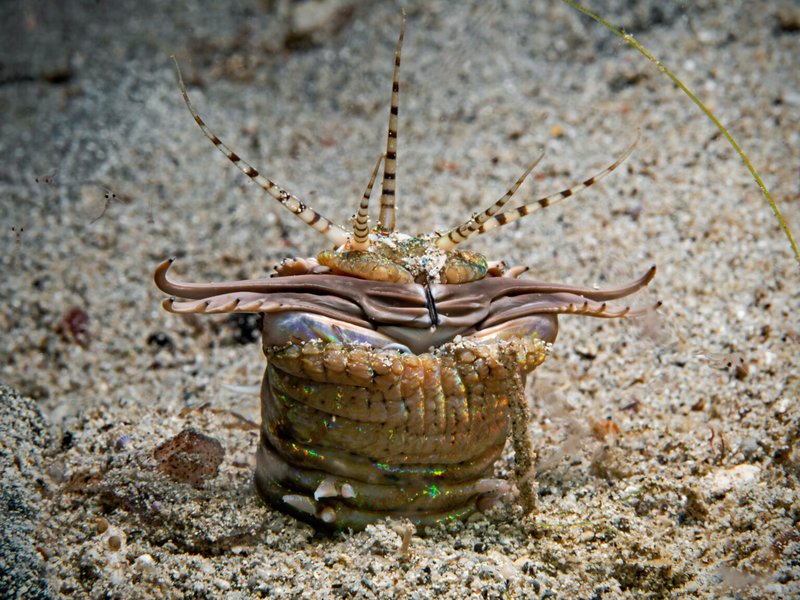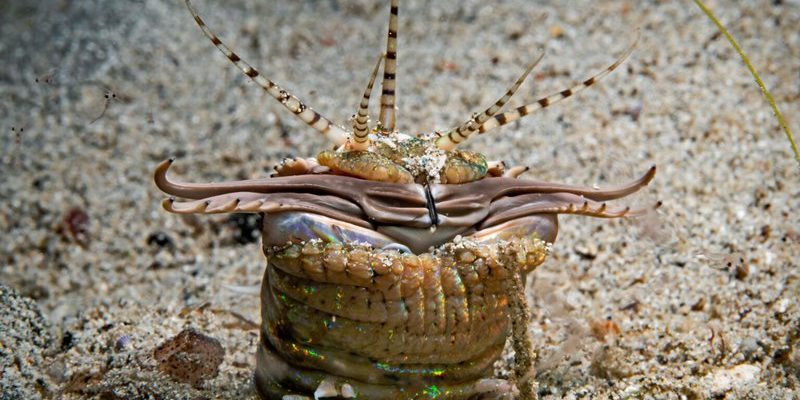
Night cameras, like those from brands such as Reolink or Arlo, allow us to see underwater activity that we would otherwise miss. These devices are designed to capture clear images in low light, revealing not just the Bobbit worm but also the rich tapestry of life around it.
Understanding Bobbit Worms and Their Habitat
Let’s start by getting to know Bobbit worms a bit better. Imagine a long, segmented animal that can stretch up to 10 feet! With their vibrant colors, they hide in the sand and ambush unsuspecting prey. They’re a type of marine polychaete worm and can be found in warm, tropical waters around the world.
These worms build tube-like structures in the ocean floor that serve as both shelter and a hunting ground. They bury themselves, leaving only their fierce, spiny heads exposed, ready to strike. Given their unique hunting strategy, observing them with night cameras can unlock insights into their behavior that’s usually hidden from our eyes.
Why Night Cameras Are Perfect for Monitoring
Honestly, traditional observation methods at night can be a challenge. Think about it: how do you light up a dark ocean floor without disrupting the natural environment? This is where night cameras come into play. They’re equipped with infrared technology, allowing them to capture crystal-clear images in complete darkness without scaring away the creatures they aim to study.
Using these cameras, researchers can monitor Bobbit worms in real-time. You might be wondering why this is important. Understanding how they hunt, interact, and thrive in their habitat can give us valuable information about the ocean ecosystem and even help us in conservation efforts.
Choosing the Right Night Camera
When you’re selecting a night camera for monitoring Bobbit worms, consider the following factors:
- Resolution: A higher resolution will provide clearer images, which is essential for identifying behaviors and interactions.
- Infrared Capability: Ensure the camera has good low-light performance so you can capture movements even in pitch darkness.
- Durability: Look for cameras that are waterproof and can withstand the ocean’s salty environment.
- Battery Life: Long battery life means you won’t have to constantly reset or recharge, allowing for longer monitoring periods.
Two brands that have made a name in this field are Reolink and Arlo. They offer various models suited for outdoor and underwater surveillance, making them ideal for researchers looking to dive into the hidden lives of Bobbit worms.
Setting Up Your Night Camera
Setting up your night camera might seem daunting at first, but it’s really quite straightforward. Here’s a simple step-by-step guide to get you started:
1. Select the Right Location: Find an area where Bobbit worms are known to inhabit, preferably with minimal disturbances from waves or currents.
2. Mount the Camera: Secure it to a stable platform, ensuring it’s aimed at the sand where the worms are most likely to be found. A small tripod can work wonders here.
3. Power Up: If your camera runs on batteries, make sure they are fully charged. Some models even allow you to connect to a power source for extended monitoring.
4. Adjust Settings: Set the camera for motion detection and ensure the infrared is activated. This way, it will start recording when it senses movement.
5. Test and Observe: Before leaving the setup, do a quick test recording to ensure everything is working properly.
With your camera set up, you’re now ready to monitor Bobbit worms and their nightly adventures!
Analyzing the Footage
Once you’ve captured the footage, it’s time to dive into analysis. Watching Bobbit worms in action can be both thrilling and educational. Look for key behaviors such as:
– Hunting Techniques: How do they strike at their prey? Do they display any unique strategies?
– Interactions with Other Species: Are they social, or do they prefer solitude? How do they interact with other marine life?
– Adaptations and Response: How do they respond to changes in the environment, like light or disturbances?
Taking notes while watching the footage can help you gather your observations systematically. You might even discover patterns you didn’t expect!
Challenges and Troubleshooting
Like any technology, using night cameras does come with its challenges. Sometimes, you might find the footage isn’t as clear as you hoped. Here are a few common problems and solutions:
– Blurry Images: Check the camera lens for dirt or algae build-up. A clean lens ensures sharp images.
– No Footage Captured: This might be due to the camera not being triggered. Review the motion sensitivity settings and adjust them if necessary.
– Battery Drain: If the battery runs low quickly, consider lowering the resolution or the frequency of recordings to save power.
Understanding how to troubleshoot these issues will enhance your experience and ensure you get the most out of your monitoring efforts.
Potential Insights from Bobbit Worm Studies
The information you gather from monitoring Bobbit worms can be incredibly valuable. Here are some potential insights you might uncover:
– Ecosystem Health: The presence and behavior of Bobbit worms can indicate the overall health of the marine environment. They play a role in maintaining the balance of the ecosystem.
– Behavioral Patterns: Understanding their hunting habits may help in predicting their interactions with other species, which can be crucial information for researchers studying marine food webs.
– Conservation Efforts: Your findings might contribute to conservation strategies, especially as ocean habitats face increasing threats from pollution and climate change.
By taking the time to study these unique creatures, you’re not just watching—you’re contributing to the broader understanding of marine life.
In conclusion, monitoring Bobbit worms with night cameras opens up an exciting avenue for exploration. With the right tools and a curious mindset, you’ll gain insights that can deepen our understanding of these captivating creatures. Just remember, the sea is an ever-changing place, and being patient will reward you with discoveries you never thought possible. Happy observing!

